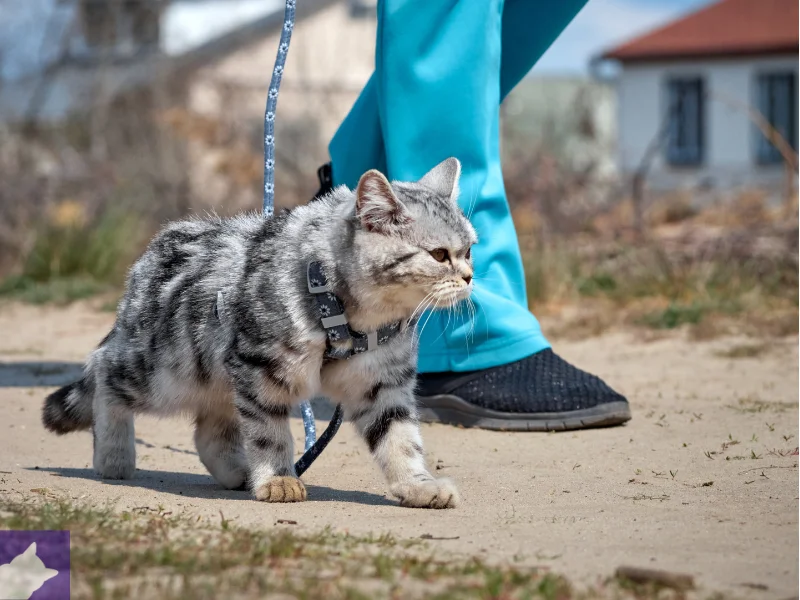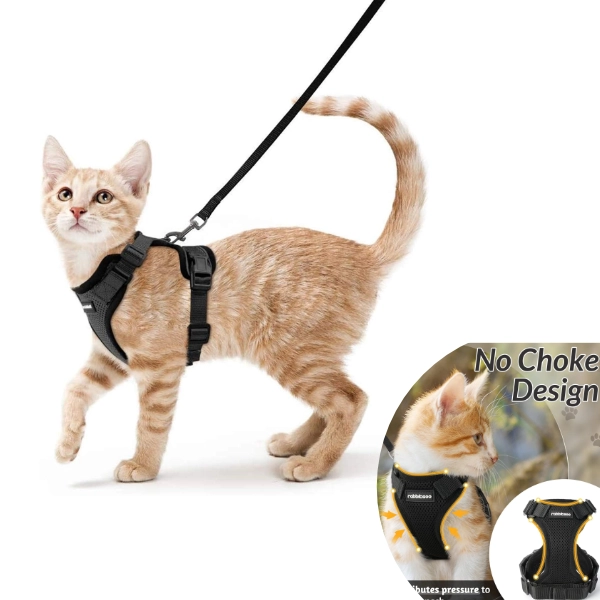
We may earn a commission when you purchase via our links at no extra cost to you.
We only share resources that meet our high standards
How to leash train a cat is an increasingly sought-after skill among pet owners who wish to safely expand their feline companions’ experiences beyond the confines of the home. Research and surveys indicate that leash walking significantly enhances a cat’s mental stimulation and physical well-being while reducing the dangers associated with unsupervised outdoor roaming. Unlike dogs, cats exhibit more cautious and independent behaviors, necessitating a patient and gradual training approach that respects their unique feline instincts and tendencies.
This comprehensive, evidence-based guide offers step-by-step techniques proven to help you successfully teach your cat to walk on a leash. Whether you are a novice cat owner or looking to provide your cat with enriching outdoor opportunities, this resource will equip you with the essential knowledge and confidence to conduct leash training safely and effectively.
Benefits of Leash Training for Cats
Before initiating leash training, it is essential to recognize the multifaceted benefits this practice offers to both cats and their owners:
Understanding these benefits underscores the value of investing time and effort into leash training, as it enriches a cat’s physical health, mental well-being, and overall quality of life.
Understanding Your Cat’s Personality and Readiness
Successful leash training begins with a thorough understanding of your cat’s individual temperament and readiness. Cats are inherently unique creatures, and their responses to training can vary significantly based on personality traits.
By carefully evaluating your cat’s personality and readiness, you establish realistic goals and foster a positive training environment, thereby enhancing the likelihood of a successful leash training experience.
Choosing the Right Equipment
Selecting the appropriate equipment is a critical foundation for ensuring a safe, comfortable, and effective leash training process for your cat. Proper gear minimizes risks and enhances the overall experience for both pet and owner.
1. Harness vs. Collar
Harnesses are unequivocally recommended over collars for leash training cats. Unlike collars, which concentrate pressure on the neck and pose risks of injury if the cat pulls or attempts to escape, a well-fitted harness distributes force evenly across the chest and shoulders, significantly reducing the risk of harm.
2.Types of Harnesses
- Vest-style harnesses provide comprehensive coverage and security, effectively preventing escape attempts. Their design also offers greater comfort for prolonged wear.
- Figure-8 harnesses are lightweight and less bulky but demand precise fitting to avoid slipping or discomfort. Improper sizing can lead to escape or injury.
- Step-in harnesses facilitate easy application, making them convenient for some cats; however, they may not be suitable for all feline body types and temperaments.
3. Leash Selection
Choose a lightweight, non-retractable leash approximately 4 to 6 feet in length. This length allows sufficient freedom of movement while maintaining control. Avoid heavy or excessively long leashes, which can tangle easily and increase the risk of accidents.
4. Safety Features
Prioritize harnesses equipped with adjustable straps to ensure a snug, customized fit. Quick-release buckles are essential for emergency situations, allowing rapid removal if necessary. Additionally, harnesses incorporating reflective materials enhance visibility during low-light conditions, improving safety during evening or early morning walks.
Preparing Your Cat for Leash Training
Effective leash training begins with thorough preparation, focusing on familiarizing your cat with the harness and fostering positive associations to ensure comfort and cooperation.
Introduce the Harness Indoor
Allow your cat to investigate the harness by sniffing and exploring it in a familiar indoor environment. Placing the harness near their preferred resting areas encourages natural curiosity without pressure, laying the groundwork for acceptance.
Positive Reinforcement
Employ treats, verbal praise, and interactive play as rewards whenever your cat shows interest in or tolerates the harness. This strategy strengthens positive associations, making the harness a source of pleasant experiences rather than stress.
Short Sessions
Initially, fit the harness on your cat for brief intervals, typically a few minutes, gradually extending the duration as your cat demonstrates increased comfort. This incremental approach prevents overwhelming your cat and builds tolerance progressively.
Observe Behavior Closely
Monitor your cat for stress indicators such as freezing, excessive grooming, or attempts to remove the harness. The presence of such signs warrants a pause in training, allowing your cat time to acclimate before resuming.
Consistency is Crucial
Conduct regular, calm, and patient sessions to facilitate adjustment. Consistent exposure within a low-stress context supports your cat’s gradual acceptance of the harness and prepares them for subsequent leash training stages.
By implementing these preparatory steps diligently, you minimize anxiety and resistance, thereby smoothing the transition toward successful and enjoyable leash walking.
Step-by-Step How to Leash Train a Cat
This section presents a systematic, progressive approach to leash training your cat, designed to maximize success while minimizing stress and resistance.
Step 1: Harness Wear Without Leash Indoors
Begin by allowing your cat to wear the harness indoors without attaching the leash. This initial phase focuses on acclimating your cat to the sensation of the harness itself. Ensure your cat has unrestricted movement and continuously apply positive reinforcement through treats, praise, or play to associate the harness with positive experiences.
Step 2: Attach the Leash Indoors
Once your cat demonstrates comfort with the harness alone, clip the leash onto the harness and permit your cat to drag it around under close supervision. This step familiarizes your cat with the added sensation and weight of the leash, reducing potential startle responses when the leash is held.
Step 3: Guided Indoor Walking
Progress to holding the leash and gently encouraging your cat to follow you indoors. Utilize motivating tools such as treats or toys to prompt movement. Keep these sessions brief and positive to maintain your cat’s engagement and prevent frustration.
Step 4: Transition to a Safe Outdoor Area
Select a quiet, enclosed outdoor space. Such as a backyard or garden that free from excessive noise and distractions. Allow your cat to explore the environment on leash while you remain close, attentive, and responsive to your cat’s behavior and comfort level.
Step 5: Gradually Increase Outdoor Walk Duration
As your cat gains confidence and shows signs of comfort, incrementally extend the duration and distance of outdoor walks. Maintain vigilant observation of your cat’s stress signals and readiness, adjusting the pace of progression accordingly.
Cats Leash Recommendation
Rabbitgoo Cat Harness and Leash for Walking

- Material: High-quality breathable mesh fabric with reinforced stitching for durability and comfort.
- Features: Adjustable fit with multiple straps, breathable mesh design, reflective strips for enhanced visibility, lightweight and soft padding, quick-release buckles for easy wear and removal, includes matching leash.
- Pros:
- Secure and customizable fit prevents escapes
- Comfortable and breathable for extended wear
- Easy to put on and take off with quick-release buckles
- Complete set with included leash
- Cons: Slightly higher price point compared to clay litters
Cat Leash Training Common Challenges and Recommended Responses:
- Resistance to Harness or Leash: If your cat resists, revert to the preparation phase, reinforcing positive associations with the harness and leash before proceeding.
- Freezing or Hiding: Avoid forcing your cat forward. Allow time for adjustment and reintroduce training with gentle encouragement at a later time.
- Sudden Pulling or Darting: Use a shorter leash to maintain control and remain calm. Sudden movements should be managed with patience to prevent escalation and ensure safety.
By following these methodical steps, owners can effectively teach their cats to walk on a leash while minimizing stress.
Safety Tips and Precautions
Ensuring your cat’s safety during leash training and walks is paramount.
- Constant Supervision: Never leave your cat unattended while harnessed or on a leash.
- Avoid Busy or Noisy Areas: Loud traffic, crowds, and unfamiliar animals can frighten cats and cause unpredictable behavior.
- Check Fit Regularly: Harnesses can loosen or shift; ensure a snug but comfortable fit to prevent escape.
- Watch for Stress Signals: Hissing, tail flicking, crouching, or vocalizations may indicate discomfort. If observed, pause training and reassess.
- Weather Considerations: Avoid extreme temperatures and wet conditions that could harm your cat.
- Emergency Preparedness: Carry a carrier or have a safe plan to quickly secure your cat if needed.
Prioritizing safety creates a secure environment that encourages positive leash training experiences.
Conclusion
Teaching your cat to walk on a leash is a rewarding endeavor that requires patience, the right equipment, and a gradual, respectful approach. This guide has reviewed the essential cat leash training steps, from understanding your cat’s personality to safely enjoying outdoor walks together.
Remember, not all cats will adapt at the same pace, and some may not take to leash walking at all. However, with consistency, positive reinforcement, and attentiveness to your cat’s needs, leash training can enrich your cat’s life and deepen your bond.
Get to know more about your feline friend with our article collection:
Understanding Cat Body Language






